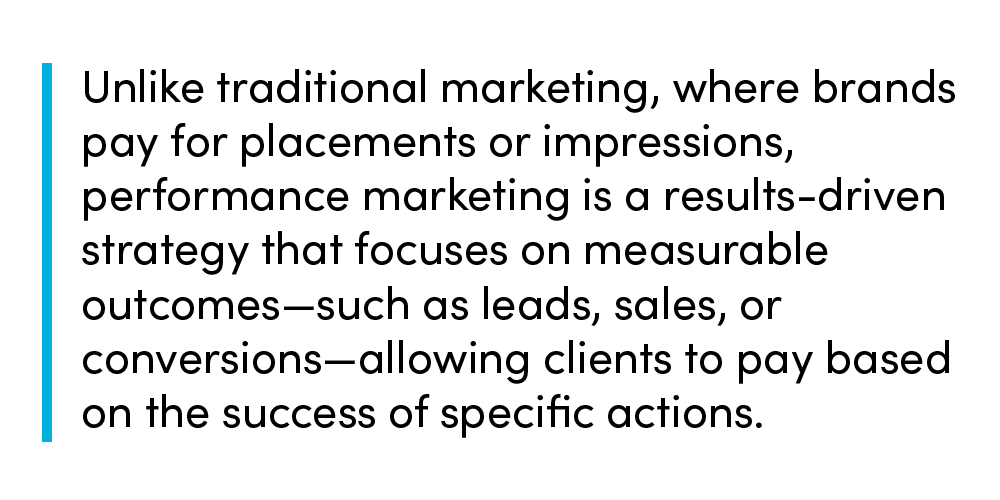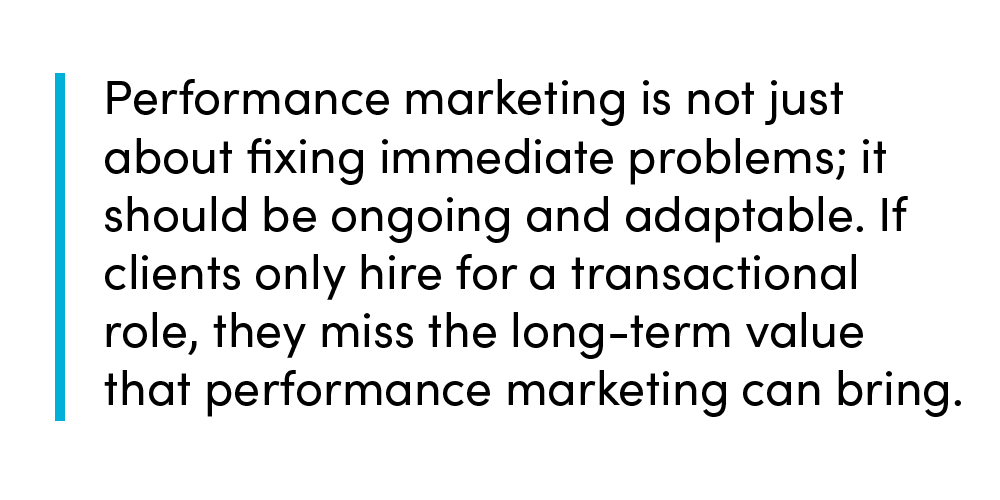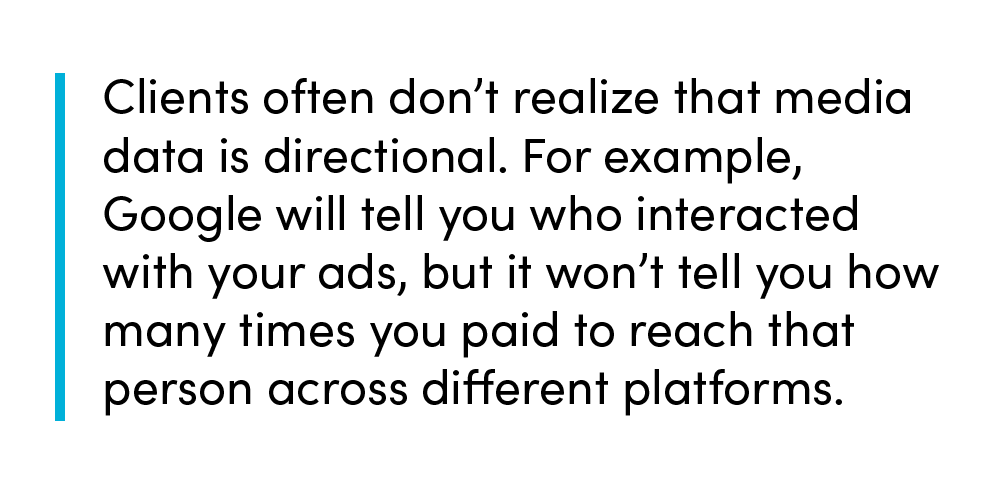While the Nielsen Ratings (which began being produced during the 1950-51 television season) once provided advertisers their primary measurement of viewership, the rise of the internet and the near ubiquity of digital advertising has given marketing seemingly infinite ways to track, measure, and quantify consumer interactions with ads. This has given way to a new subset of marketing called performance marketing.
Unlike traditional marketing, where brands pay for placements or impressions, performance marketing is a results-driven strategy that focuses on measurable outcomes—such as leads, sales, or conversions—allowing clients to pay based on the success of specific actions. Display ads are a key component of most performance marketing strategies, but social media content, native advertising, search engine marketing, and sponsored content also play important roles, depending on the client and campaign objectives.
With so much to consider in developing a performance marketing strategy, things can quickly get confusing, or at least, merely overwhelming. We recently sat down with Jordan Turner, Senior Director of Media at (amp), for help in demystifying performance marketing. In the interview below, we discuss how performance marketing fits within broader marketing strategies, key performance indicators (KPIs) that drive success, and some common misconceptions clients. We also discuss best practices for fostering long-term relationships between agencies and clients to ensure ongoing improvement and avoid purely transactional engagements.
Our conversation has been edited for clarity and length.
Can you give a brief overview of performance marketing for those of us who don’t have extensive media experience?
Performance marketing is digital marketing that focuses on a specific result. For instance, companies often hire digital performance agencies when they know they need to achieve a certain goal, like increasing leads or sales. These agencies don’t necessarily need a full agency of record (AOR) or a request for proposal (RFP) process. Companies can interview for a specific skill set in performance marketing. There are various niches within performance marketing, most driven by verticals, such as lead generation, retail, direct-to-consumer (D2C), and business-to-consumer (B2C) e-commerce.
 When would a brand typically engage with performance marketing?
When would a brand typically engage with performance marketing?
Typically, our clients have a sophisticated Chief Marketing Officer (CMO) or Vice President of Digital, who understands exactly what they need at each stage of the model. They’ll hire a Meta agency, a Google agency, a PR agency, and then engage us to play the performance marketing role. We focus on the bottom of their e-commerce funnel—when it’s time for the customer to buy. If the customer hasn’t already converted after seeing Meta ads or PR, they will likely either go to Google or type in the brand’s website directly to make a purchase. That’s when the intent is highest—after engaging with Google or visiting the brand's website.
In some cases, like lead generation, the approach differs slightly. Because Google is at the bottom of the funnel, we capture people there and make them query the brand. However, to make them search on Google, we often need something that incites that action—such as a Meta campaign. Therefore, both channels need to work together as part of a multi-step funnel, which can include more than just bottom-of-the-funnel tactics. We may be involved in consideration, but rarely in awareness.
Are there particular KPIs better suited to performance marketing?
Yes. In an executive summary, I would report the following KPIs: First, costs. How much did we spend on the campaign? Then, in a CPC model, we’re typically focused on clicks or impression base, so I’d report impressions, which leads to how many clicks we achieved. And then you have your interaction metrics in the middle of the funnel that tell you what your click-through rate (CTR) was and your CPC–meaning how efficient was your ad spend? That’s the buy side of the funnel. Then you go to your sell side of the funnel, which is conversions, conversion rates, and cost per acquisition (CPA). Those are probably the three most important conversion-related metrics.
Because if you’re working in lead generation, the focus is on generating leads, not immediate revenue. So, return on investment (ROI) wouldn't be calculated until we know how many of those leads converted into paying customers and their value. However, in an e-commerce model, conversions equate to purchases, and we also focus on Return on Ad Spend (ROAS) and Profit on Ad Spend (POAS). ROAS is the revenue generated per dollar spent, and POAS is essentially ROI, which subtracts ad spend to show the profit. When dollars are attached to a campaign, we move past conversion efficiency metrics. But when there aren’t any, we stop there in the executive summary.
What are some common misconceptions clients have about performance marketing?
One common misconception is that performance marketing is purely transactional. Clients often don’t understand that it’s digital-only. I’ve been hired for performance marketing, and months later, the client hands me a phonebook buy. That’s not what performance marketing is—it’s a waste of time for both of us if we’re not optimizing the digital aspect.
Another issue is that clients hire performance agencies to fix a problem, and once we solve it, they often think the job is done. They either say, "We’ve got it from here," or try to double down on what worked, which can sometimes break the system. Performance marketing is not just about fixing immediate problems; it should be ongoing and adaptable. If clients only hire for a transactional role, they miss the long-term value that performance marketing can bring.
 In an ideal world, what happens once you fix a problem for a client? How would your role change?
In an ideal world, what happens once you fix a problem for a client? How would your role change?
That conversation would happen before the problem is fixed. Clients often don’t realize there’s more to performance marketing than solving one issue. It’s essential to lead them toward understanding the bigger picture. Sometimes, they hire us for a specific engagement, but by the time we reach the solution, they need more. It's crucial to treat the initial engagement as a test and show them how it leads to long-term success.
Performance marketing works best when there’s clear collaboration between agencies. For example, a PR agency may handle awareness, a social media agency manages consideration, and we manage the bottom of the funnel. But if these agencies aren’t working together, you end up paying for the same customer multiple times as they pass through each media set. This can tax the system and make it unsustainable if average order values (AOVs) can’t absorb the cost.
Can you give an example of a successful collaboration where you managed performance marketing alongside broader media scope?
A great example is True Food Kitchen. They are primarily brand marketers, but their Chief Growth Officer, who has a background as a CMO, understands data well. We aren’t their agency of record (AOR), but we handle their performance marketing. We manage the digital side of their funnel, ensuring that everything aligns with their broader brand marketing efforts.
True Food Kitchen appreciates that we focus solely on performance, allowing us to excel in that lane. We don’t handle analytics, creative, SEO, or user experience (UX/UI) for them, though we could. They trust us to manage the performance side, and we respect the boundaries they’ve set for each agency.
Learn how (amp) helped True Food Kitchen reverse a 5-year performance decline here.
What’s the first issue you typically need to address when working with a new client?
The first issue is usually understanding why numbers don’t match. Clients often don’t realize that media data is directional. For example, Google will tell you who interacted with your ads, but it won’t tell you how many times you paid to reach that person across different platforms.
A client may see that Google reported a click that cost $3, but in reality, that same person may have also seen a YouTube ad for 25 cents, clicked a Facebook ad for $5, and finally converted after seeing a Reddit banner. So, while the conversion might look like it cost $3, the true cost is much higher. The biggest mistake clients make is focusing too much on directional data instead of looking at the overall dollars and cents. If revenue is up, it’s often less important to focus on why CPCs doubled if profits also doubled.
 This has been a great conversation. Is there anything else you’d like to add?
This has been a great conversation. Is there anything else you’d like to add?
I feel like I’ve been on a bit of a soapbox, but this is a topic I’m really passionate about. Clients need to understand that performance marketing isn’t just about solving a single problem; it’s about ongoing improvement. We need to move beyond thinking of performance marketing as purely transactional and instead foster a more conversational and strategic approach.
See more recent client work and performance marketing success stories on our
website.